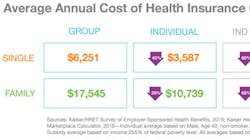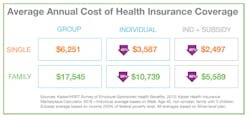Wise-up Wednesday from Zane Benefits: Making health benefits affordable for small dental practices
As dental practices evaluate how to offer affordable health benefits that also meet the benefit expectations of their staff, there are three key opportunities to understand and leverage: (1) the affordability of individual products, (2) government subsidies, and (3) the ability to reimburse individual health insurance premiums.
This article provides a manager-level summary of these three topics. Let’s dive in.
1. Better individual products, with lower costs
As dental practices evaluate how to contribute to employees’ health care, employers are taking a second look at individual health insurance policies. That’s because since 2014, individual products have improved and generally have lower costs than group policies.
Here are a few stats:
• The average group health insurance policy in the U.S. costs $6,251 a year for single coverage.
• The average individual health insurance policy in the U.S. costs $3,587 a year (43% less) for single coverage, or $2,497 a year (60% less) for those who qualify for subsidies.
• With group health insurance, the average employer contributes $5,180 a year for single coverage and $12,590 a year for family coverage.
• Given the cost of individual policies, the average practice could fully fund an individual or family policy for less than they could fund a portion of that employee’s coverage under a group policy.
In addition to lower costs, individual policies are now similar to group-based policies. For example, individual policies must cover all applicants regardless of health conditions, and must cover essential health benefits.
2. Government subsidies
Adding to the affordability of individual policies are the government subsidies available with individual health insurance.
Here are a few stats:
• In 2015, 85% of people with active Marketplace coverage received a subsidy.
• The average health insurance subsidy was $272 a month, or $3,264 a year.
• 80% of Marketplace shoppers purchased coverage for less than $100 a month, after their subsidy.
3. Reimbursing premiums instead of paying them
As we’ve outlined here, the cost of individual health insurance and health insurance subsidies are two factors making health benefits more affordable to dentists and their staff.
But you may be thinking, where does the employer contribution come in? The answer is by reimbursing premiums instead of paying them. Rather than purchasing a small group health insurance policy to cover eligible employees and dependents, a more cost-effective approach is to set up a formal health care plan to reimburse employees for individual health insurance premiums.
Here are a few facts:
• Employers may use a formal, tax-advantaged reimbursement plan (such as an HRP) to reimburse individual health insurance premiums. This type of plan complies with existing federal rules and reforms.
• Employers may also help employees with a taxable bonus or raise.
• Employers should avoid paying for individual health insurance premiums directly, or reimbursing employees outside of a formal, compliant reimbursement plan. These practices are considered non-compliant employer payment plans and employers could face steep fees.
• A May 2014 analysis by S&P Capital IQ, a division of McGraw Hill Financial, projected 90% of employees currently receiving health insurance through their employers could be shifted to individual health insurance and public exchanges by 2020, just four years away.
• This approach seems to be taking off among small businesses. After all, small employers with fewer than 50 full-time employees are not required to offer health insurance under the Affordable Care Act and are statistically less likely to offer traditional insurance because of cost barriers.
Conclusion
As small dental practices look at ways to offer affordable and quality health benefits, remember these three key opportunities. Hopefully there is something that’s perfect for your practice and employees.
RECENT WISE-UP WEDNESDAYS:
Employee retention strategies for dentists; real costs of losing an employee
How much will individual health insurance reimbursement cost your dental practice?
Will retirement of baby boomers shrink the dental industry?
To learn more about individual health insurance reimbursement, download the free guide “The Dental Practice's Guide to Individual Health Insurance Reimbursement.” Wise-up Wednesday is presented bi-monthly from the experts at Zane Benefits. One Wednesday a month features Human Resource issues, and the other Wednesday discusses health benefits.






